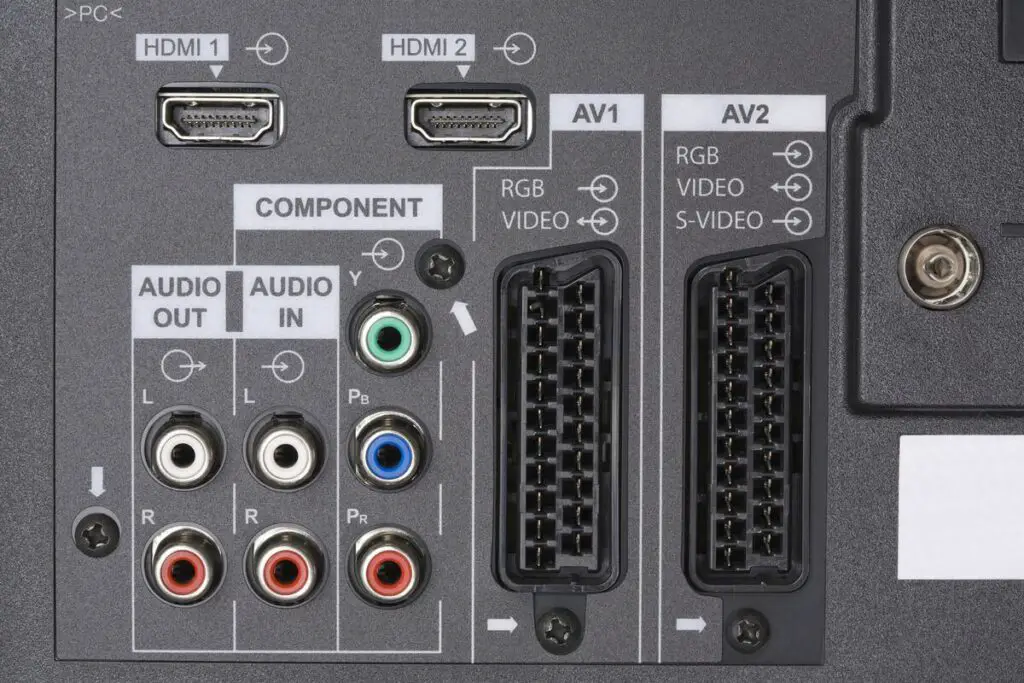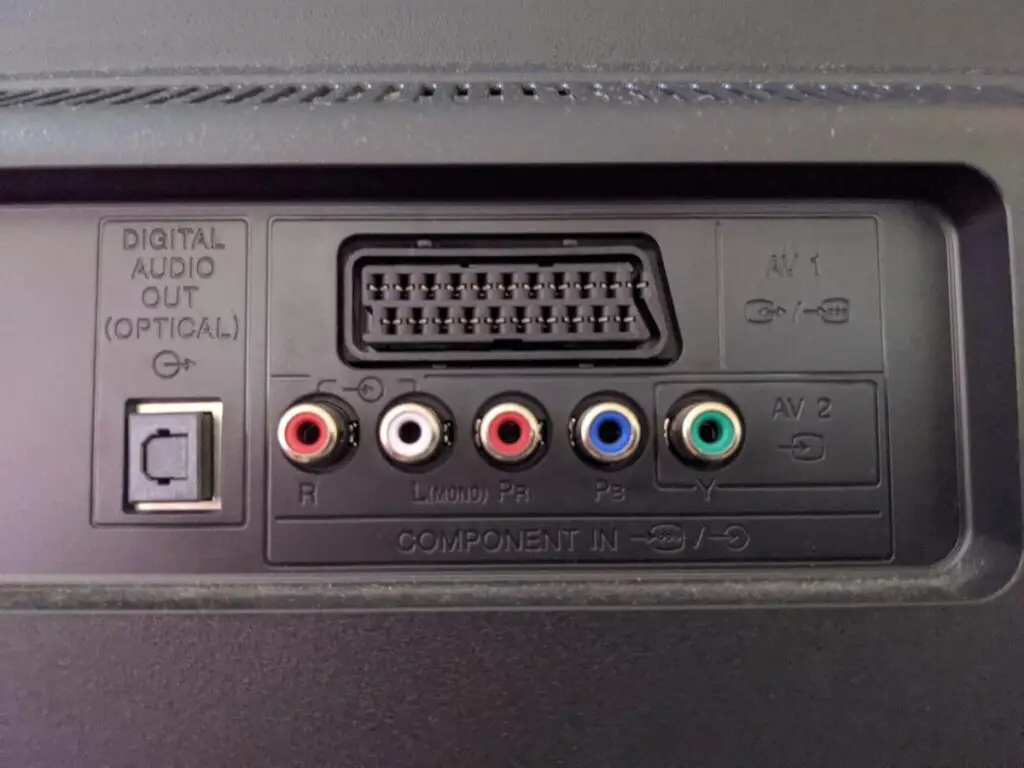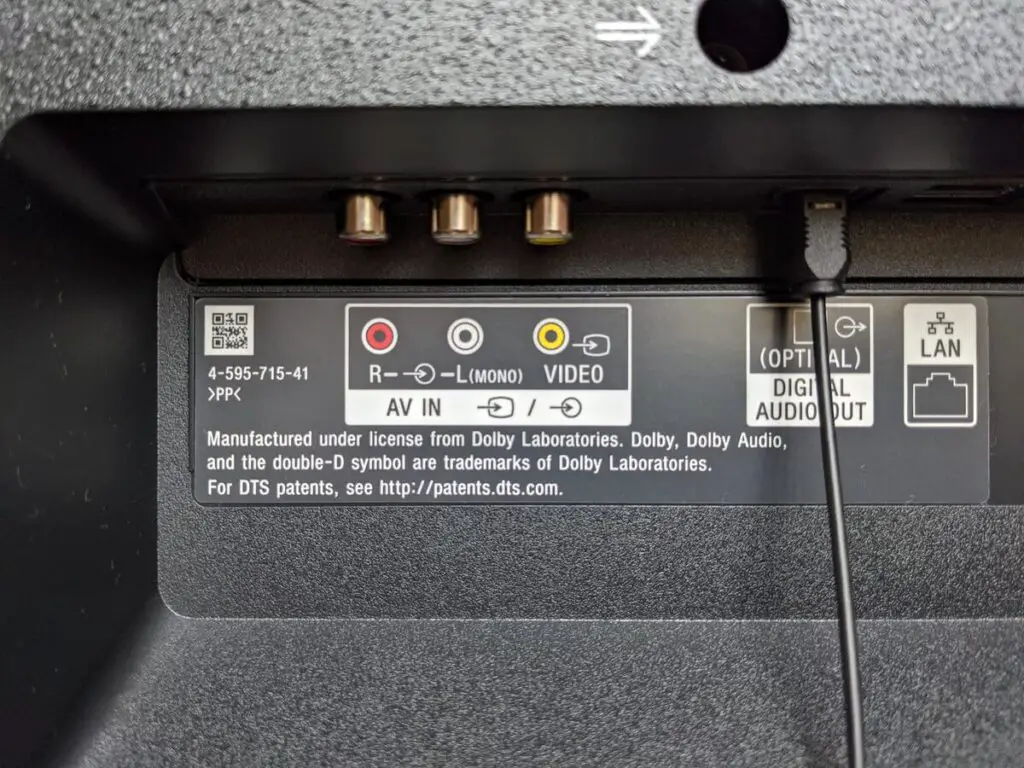Smart TV Inputs And Outputs: 27 Answers (For Beginners)
Disclosure: Tech Parasol is supported by its readers. When you purchase through links on our site, we may earn an affiliate commission. Thank you.
Smart TVs have many different inputs and outputs. And if you haven’t purchased a new TV in a while, you may want to know what ports the latest Smart TVs have on them.
Here’s What You Need to Know about Smart TVs and Inputs and Outputs:
Smart TVs have ethernet ports, RCA inputs, component inputs, HDMI and coax inputs. Newer Smart TVs have HDMI ARC and USB ports. Inputs such as RCA, component, scart and VGA are becoming less common on newer TVs and are being superseded by HDMI and DisplayPort.

Do Smart TVs have ethernet ports?
Most, if not all Smart TVs have ethernet ports.
Connecting a Smart TV to your router using an ethernet cable is more secure than WiFi. It will also result in a more stable connection.
Do Smart TVs have RCA inputs?
RCA inputs are available on some Smart TVs but not all.
RCA sends analog video signals in standard definition and both the color and black and white parts are transferred together.
Even though analog RCA has largely been superseded by HDMI which carries digital signals, RCA (sometimes known as composite AV) is still available.
On many TVs this may be labeled as:
- Video
- Video line-in
- AV-in (if paired with analog stereo audio inputs)
I have a Sony Bravia 42 inch that has an RCA input for audio only (red/white), see the image below:

However, I also have a Sony Bravia 49 inch (a later 2021 model) that has an RCA input that has the red, white and yellow (video) inputs (see below).

In other words, it totally depends on the model.
Do Samsung Smart TVs have RCA inputs?
Some Samsung models have composite video inputs.
The Samsung 32″ Class N5300 Series and the Samsung 32″ Class M4500 Series both have composite video inputs.
Do Smart TVs have AV inputs?
Some Smart TVs have AV inputs, others don’t and it depends on the model.
If a TV has component inputs but doesn’t have the yellow video input (known as AV), then you can plug the yellow RCA cable into the green input (labelled “Y” and/or “video”).
Do Smart TVs have coaxial inputs?
Most Smart TVs have coaxial inputs but some don’t.
In particular, some Vizio TV models have been sold without tuners.
These have been marketed as “home theater displays” rather than TVs.
The reason for this, according to FCC regulations, is that a TV cannot be sold as a “TV’ without a built-in tuner.
But generally TVs that don’t have tuners built-in are called “monitors” or video displays.
So what do you do if your “TV” doesn’t have a coaxial input/tuner?
Well, you would need to buy a digital tuner box, like this one on Amazon (#ad).
These boxes have a coaxial input and a HDMI output for easy connection to your TV.
This particular box also supports TV recording and digital media playback by connecting a USB drive to the USB-port.
The only downside of this is that you have yet another remote control to add to your collection!
The good news is most manufacturers continue to integrate tuners into their TVs.
But this may change in the future as manufacturers look to cut costs or if there’s a trend to indicate people are no longer tuning in to over the air channels.
Here’s a couple of things to consider before buying a TV if you tune in to watch over the air channels:
- Make sure that the word “TV” is in the product title and not simply “display”.
- Check the specs and look out for wording such as an antenna, “RF”, coaxial, or cable TV input.
Do Smart TVs have component inputs?
Component inputs are available on some, but not all Smart TVs.
Components are more sophisticated than composite and are technically capable of handling resolutions up to 1080p.
The video signal can also be progressive or interlaced (the “p” or the “i” at the end of ‘1080’).
However, the HD capabilities of the component were phased out in 2011 for copyright reasons.
Modern TVs tend to combine a component input with a composite input into a single video input option.
This is also called a shared connection.
Do Smart TVs have aux?
Most Smart TVs have an auxiliary, or AUX output, but some don’t.
Some of the newer Samsung TVs don’t have an AUX out. If a TV doesn’t have one, then you can buy an Optical to 3.5mm adapter.
Do Smart TVs have DisplayPort?
A handful of Smart TVs have DisplayPort, but most don’t and only support HDMI.
The following Smart TVs have DisplayPort outputs:
- HP Omen X Emperium 65
- The ASUS ROG Swift PG65UQ
- Philips Momentum 558M1RY
- Alienware 55 OLED
Do Smart TVs have HDMI video output?
Smart TVs don’t have HDMI video output. The HDMI ports on Smart TVs are Inputs.
The HDMI inputs receive digital video and audio signals from external sources such as streaming devices, cable TV boxes, DVD/blu-ray players etc.
Do all Smart TVs have HDMI ARC?
Most new Smart TVs support HDMI ARC.
The ARC bit stands for “Audio Return Channel” and allows HDMI to simultaneously send and receive audio signals using the same HDMI cable.
This can eliminate the need for optical cables because the TV can connect directly to a soundbar using HDMI.
Do all Smart TVs come with a HDMI cable?
Most Smart TVs do not come with a HDMI cable.
Do Smart TVs have USB ports?
Smart TVs do have USB ports. They can be used to connect USB flash drives or provide power to an antenna or streaming device.
They can also be used to charge a Smartphone.
Do Smart TVs have headphone jacks?
Some Smart TVs have headphone jacks, others don’t. It depends on the make and model of the TV.
If your TV doesn’t, you still have some options to connect your headphones.
If the TV has an RCA audio output, then you can buy a RCA-to-3.5mm adapter to connect your headphones to the TV.
Some of the more modern Smart TVs don’t have analog RCA audio outputs. Instead they tend to have digital audio outputs.
So you’ll need a digital to analog audio converter like this on Amazon (#ad).
This converts a digital audio signal from your TV and converts it to an analog signal required for headphones using a 3.5mm headset jack.
Alternatively, you can go the wireless route and get some bluetooth headphones.
You can then get a bluetooth transmitter like this on Amazon (#ad) which accepts a variety of inputs from the TV such as Optical, AUX and RCA Audio output.
Do Smart TVs have memory storage?
Smart TVs do have memory storage in order to install apps. But the storage is limited.
Many Smart TVs have USB ports so that you can expand the storage if required.
Do Smart TVs have SD card slots?
Most newer Smart TVs don’t have SD card slots.
But it is possible to connect an SD card reader to a Smart TV with a USB cable.
Do Smart TVs have optical outputs?
Smart TVs do have optical outputs.
These can be used to connect a TV to a soundbar and other audio equipment such as amplifiers, AV receivers and HiFi DACS (Digital to Analog Converters)
Do Smart TVs have a VGA connection?
Some Smart TVs have a VGA connection.
VGA, which stands for Video Graphics Adapter (or Video Graphics Array), is typically used to connect a computer to a display such as a Smart TV or monitor.
Do Smart TVs have SCART sockets?
Some Smart TVs have SCART sockets, but newer ones often don’t. The successor to SCART is HDMI.
If you have some old consoles or video equipment that still rely on SCART, then you can get a SCART to HDMI converter, like this one on Amazon (#ad).
Do Smart TVs have HDMI ports?
Smart TVs do have HDMI ports and most have at least 2-3 ports. TVs that support the higher bandwidth HDMI 2.1 have been available since 2019.
Having just 2-3 ports can be frustrating given that many people own a plethora of devices including game consoles, digital receivers and streaming sticks.
But it is possible to add more HDMI ports to your TV by purchasing a HDMI switch. This will enable you to switch between devices at the click of a button.
Do I need an HDMI cable for my Smart TV?
A HDMI cable isn’t required for a Smart TV. But if you plan to use external devices such as a game console, then you’ll need a HDMI cable.
HDMI cables carry video and audio data in an uncompressed format, allowing for the optimum picture and sound quality.
These cables are required when both the TV and the device you want to connect to it have HDMI jacks.
But the type of HDMI cable you need depends on the resolution of the content being transferred.
For example, Full HD (1080p) TVs and standard Blu-ray players will need a HDMI 1.4 cable.
But if you have a 4K TV and 4K Blu-ray player, you’ll need to use a HDMI 2.0 cable which is capable of transferring 4K video at 60 frames per second (fps).
If you’re a gamer, some titles offer a higher refresh rate at 120Hz. In this case you might want to go for a 2.1 cable to ensure smooth gameplay.
It’s also worth pointing out that you don’t need to shell out for an expensive cable.
Cheap HDMI cables can perform just as well as expensive ones.
What kind of HDMI cable do I need for Samsung Smart TV?
You can use any standard HDMI cable but to take full advantage of a 4K device with a 4K Samsung TV, you should opt for a HDMI 2.0 cable.
Do Smart TVs have HDMI outputs?
Smart TVs do not have HDMI outputs. The HDMI ports on Smart TVs are inputs for receiving uncompressed video and audio from external devices such as streaming sticks and blu-ray players.
Having said that, there’s a new HDMI port called HDMI ARC, which has the ability to output audio.
With HDMI ARC, audio is sent in the reverse direction to what it would normally be sent with ordinary HDMI.
In a typical setup you might have a soundbar or receiver, where you have multiple devices connected via HDMI.
You would then connect a HDMI cable from a soundbar or receiver to the TV.
But if you’re watching Netflix on your Smart TV for example, you would normally need a digital audio cable connected between the TV and the soundbar in order to hear it.
HDMI ARC eliminates the need for this additional audio cable by allowing audio to be sent back from the Smart TV to an ARC-compatible receiver or soundbar using the same HDMI cable.
In order for ARC to work correctly, HDMI-CEC may have to be enabled on your TV and all devices must be ARC-compatible.
Do I need an Ethernet HDMI cable for Smart TV?
Ethernet HDMI cables aren’t required for a Smart TV.
The idea is that HDMI Ethernet Channel (HEC) cables can carry data between devices, allowing them to share wired Internet connections up to 100Mbps.
But most devices don’t support HEC.
The reason for this is that WiFi and regular ethernet technologies have come on leaps and bounds in recent years and are already cheap and fast enough.
For this reason manufacturers haven’t bothered to build equipment to support HEC.
Interestingly, HDMI ARC (Audio Return Channel) that is widely used, uses the same pins as HEC.
And sometimes, but not very often, the two technologies are combined into one acronym – HEAC.
HDMI cables that are labeled as High Speed or ARC compatible are also HEC compatible.
Do TV HDMI ports go bad?
HDMI ports can break by plugging and unplugging the HDMI cable too many times or by pushing the cable into the port with sufficient force or at an angle.
They can also break when a sudden force pulls the cable out of the port.
If the port does get damaged, you will either a black screen often with “no signal” or “no input” on the screen when plugging in an external device.
Alternatively there may be other symptoms including:
- Distorted picture (fuzzy, blurry or sparkling)
- Intermittent picture
- No sound or intermittent sound
- Discolored picture or poor resolution
- Remote controls that don’t work
Why do TVs only have two HDMI ports?
Not all TVs have just two HDMI ports, some TVs have four. Some higher end TVs such as the LG C1 have four HDMI 2.1 ports.
So it very much depends on the make and model of the TV.
But many people like to use soundbars or receivers as they upgrade their TVs.
There are two reasons why you would want to use a soundbar or receiver:
- The speakers that are built-in to TVs don’t sound as good as a dedicated sound system. This is because the speakers themselves can’t be made large enough to fit into TVs, which seem to be getting thinner every year.
- You can run many devices to soundbar or receiver and connect the output to a single port on the TV to deliver the video signal.
This reduces the number of HDMI ports you need on your TV.
Also, with the advent of HDMI ARC, it is now possible to send audio back to the receiver or soundbar over the same cable.
This will enable the sound generated from the built-in apps to be played through your audio system.
It also reduces the amount of cabling you need.
Of course if you do want extra HDMI ports, then you can always buy a HDMI switch instead.
Is my TV HD if it has HDMI?
A TV is only HD if it has a resolution 720p or higher regardless of whether or not it has HDMI ports.
HDMI ports are designed to accept HD video but they do not guarantee that the TV itself is capable of displaying HD resolution.
If you try to play HD content on a lower resolution TV, then the content will be downscaled for display.
That being said, TVs that don’t have HD resolution won’t need and probably won’t have HDMI ports on them.
A TV that isn’t a flat screen, LCD, OLED or plasma won’t have HDMI ports.
Old CRT TVs for example won’t have them.
Are all 4K TVs HDMI 2.1?
Not all 4K TVs support HDMI 2.1. Most 4K TVs support HDMI 2.0.
But 4K TVs that support higher refresh rates like 120Hz as well as 8K TVs (at 60Hz) support HDMI 2.1.
HDMI 2.1 supports dynamic HDR formats and 48Gbps bandwidth which is required to deliver uncompressed 8K video with HDR and uncompressed 4K video at 120 frames per second.
HDMI 2.1 also delivers:
- eARC which simplifies connectivity with audio devices.
- Enhanced gaming features such as Variable Refresh Rate (VRR), Auto Low Latency Mode (ALLM) and Quick Frame Transport (QFT).
- Quick Media Switching (QMS) to eliminate the delay and the blank screen you get before content is displayed.
Sources
Lifewire: Tech News, Reviews, Help & How-Tos
How to Use Headphones With Your TV
Best HDMI cables 2021: 4K and high-speed

Robert Anderson
Robert Anderson, the founder of Tech Parasol, had a keen interest in tech from a very young age. He studied Electronic Engineering at University and then went on to become a Software Developer. He launched Tech Parasol in 2021 to share his knowledge with the aim of making tech easier to understand for everyone.
